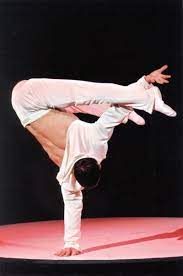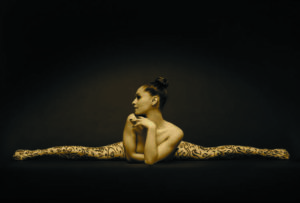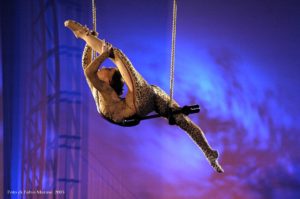Generalists vs Specialists
Since the dawn of the new century, a shift has been happening in the circus world, and multidisciplinary circus artists have been sought out for new stages, shows, and companies. But specialists of one discipline are here to stay. Looking to performers of the past and present, Martin Frenette breaks down the appeal of generalist versus specialist artists– and how each one can thrive in the contempary market.
When Frank Sinatra walked on stage at Caesar’s Palace in 1982, he did so with his show tuxedo and signature smile. The Las Vegas audience enthusiastically waited for “Fly Me to the Moon,” “New York, New York,” and other classics. They had come to see a polished act. The same could be said of those who attended Rizoma at Berlin’s Wintergarten in 2007.

Unlike Sinatra’s fans, rare were the ticket holders who could spell Anatoly Zalievsky’s name. The Ukrainian hand balancer gained world fame in 1998 and became a recurrent face on stages around the globe. Spectators of all ages were touched by the way he moved: some memorized his entire piece, and even the most casual showgoer remembers his white costume and the iconic slides up from straddle.
If Frank Sinatra is the face of Vegas’ golden era to many, then Zalievsky has become the symbol of the circus’. Even though the latter never appeared on late-night talk shows and wasn’t featured on magazine covers as much as the former, both artists went down in history as headliners.
Zalievsky burst into the scene during what some refer to as the German cabaret renaissance. Most shows were hosted by an MC or a singer who introduced a handful of acts that hardly had anything in common. Anything but this polish, that precision, and this unteachable stage presence. Every single detail, from the sinuous way one hand would grab a trapeze rope, to the position of a jewel in a headpiece and an arabesque precisely following a violin string, had been thought of. Many artists came from traditional circuses, where they had created and run their acts two or three times a day, while others were artistic directors’ protégés with an act created for them. Finally, young artists saw this market as a perfect place to perform the act they’d worked on in a gym or at a circus school.

Cut to 2022, where graduates have traded custom-made costumes for attires found in thrift stores, and having “just an act” no longer seems to be a must. In Circa‘s En Masse, Machine de Cirque‘s Truck Stop, and The 7 Fingers’ Passagers, circus artists tumble, dive through hoops, get propelled from a teeterboard, or pass a few clubs. There are solo acts, but they’re not the main focus. In today’s contemporary circus scene, an artist’s skills are more important than their act, and the more skills one has, the higher the chances of being hired are.
Is the 21st century the generalists’ era? Which artist is more likely to get hired in the current market?
“The business has changed and specialists aren’t as needed as before. Modern shows have more of a storyline with generalists doing a little of everything. Directors have more control over what they want to present and the way to do so,” says director and former trapeze artist Aurelia Cats.

As an art form, circus is evolving by moving away from the cabaret form and into integrated ones. In the same way that a corps de ballet or a musical ensemble joins forces and thinks as one to create their show’s big picture, young artists use their skills to make the production memorable rather than their solo acts.
Going back twenty years in time, artists were deemed unreplaceable because there only was one Oleg Issosimov, Kris Kremo, or Miss Mara. Specialists were stars who could not be replaced. Therefore, one must assume that this problem no longer exists. Nothing looks like a flyer more than another one! If an acrobat is out, their former classmate can undoubtedly fill in, right? However, finding an artist who matches exactly another’s profile can be as tricky as setting up a teeterboard and two crash mats in twenty-and-a-half seconds! If an acrobat sings, does three different one-arms, throws a double back on the trampoline, and catches clubs behind his back, whoever steps in must have those exact skills to maintain the show’s rhythm and narrative.
If modern shows are ensemble pieces that rely on a collective’s energy and group acts, the choice of becoming decently skilled in a few disciplines rather than investing so much in a single act makes sense.
“Many young artists create shows, projects, and hybrid forms. Creating the perfect six-minute act no longer is their only goal,” says Shana Carroll from The 7 Fingers.
In comparison to a musician’s ten-track album or a movie maker’s 90-minute project, six minutes sounds rather short to express something artistically. Are circus artists of the 21st century feeling time-constrained? Is this the reason behind the striking difference between the acts of the younger generation and their predecessors? What’s the secret behind an act’s unforgettable signature?
There are no “Sinatras of the circus” and yet, producers once relied on different kinds of headliners to attract big crowds: “the first and only quadruple salto on the flying trapeze in Italy,” “the United States’ youngest cannonball woman,” or “Monte Carlo Circus festival’s gold medalist”!

Some had a recognizable costume, others became known for their silhouette or good looks, and there were those who heavily promoted their hardest trick. By marketing themselves as unique and fine-tuning the formula each time they went on stage, circus artists managed to outshine the animal acts and other big attractions. They redefined what headliners were and employers use their acts’ names and fame to fill their seats.
Strong of the success they encountered in and above the circus ring, many artists benefited from this cabaret renaissance and traded circus tents and trailers for theaters and apartments. Cabarets having always programmed famous faces and well-established acts, circus performances with cachet and certain notoriety became the new norm. The Pellegrini Brothers, Duo Mouvance, the Zebras, and Aurelia Cats went from the Lido to the Tigerpalast and from the Wintergarten to Palazzo.

In the same way that a diehard fan could attend Ray Charles’ or Barbara Streisand’s concert multiple times without a single note being changed, audiences saw the same, detail-oriented circus act in different houses. A new generation of artists opted for that same path, creating a bridge between the tradition and a new one in the making: Philipp Tigris’ hula-hooping sailor, Natalia Vasilyuk’s spinning contortion, the Swiss-American Vertical Tango, or Vanessa Alvarez’s foot-juggling Señorita. Fuelled by passion and a desire to find their niche in this industry, they followed the “signature act” trend. That meant reaching a strong technical level, finding a piece of music to choreograph the act to, and getting a one-of-a-kind costume. Many are still performing, 20+ years down the road, and will at times get paired with colleagues who followed a different trend.
In spite of the growing number of young artists choosing to be generalists, some still have soloist aspirations. However, given that many companies put the ensemble and narrative first, newcomers can sometimes come off as bland or cut from the same cookie sheet. Considering the “casual pedestrian” vibe modern shows convey and the more accessible or relatable look embraced by their cast, artists in training might no longer see the point of having an act set in stone. Less time and resources are invested in creating a solo piece likely to be altered when joining a company. Consequently, the “casual pedestrian” has become the rhinestone of the late 2000s.
“Creativity and watching people with a strong presence on stage are what matters to me. I have a hard time with H&M clothes, no makeup, and messy hair. A great act that has it all (technical, costume, music, and personality) will always be at another level. I rarely remember names or faces anymore while I still remember many from older times. In any case, an artist that touches us in one way or another will be remembered for years,” concludes Ms. Cats.

There is no denying that circus must evolve to keep on growing and remain relevant as an art form. There would be no contemporary circus if artists of all ages hadn’t embraced trends and traded old habits for new, risky ones. However, there is nothing modern without the classic that inspired it. No graduates from Berlin’s Staats Schule, Montreal’s ENC, or ACAPA would appear on those infamous stages if previous generations hadn’t made these shows happen in the first place. The question is: can these two styles share the same light and how?
There is a time and a place for casual-looking costumes and a somewhat less polished image. Some find it easier to connect with artists who go on glitter-free with a song seemingly picked from a recent playlist. Seeing Stravinsky’s “The Rite of Spring” performed by a street dance mob in hoodies is far more appealing to that audience. Dancers who don’t feel right about tights and pointe shoes can better express themselves in such a context; so can the jeans-wearing juggler who’d rather spend 15 minutes slowly rolling a ball with techno music than perform a move-by-move choreographed solo in a tailor-made costume.
When the curtain rises, it’s about what the show wants to be and what its cast wants to convey. It might be called a “variety show” but some acts and artists need more backstory and an elaborate set-up. Is it an artistic mistake to program such acts along with those “classic six-minute pieces”? Can a specialist look as raw and authentic as a generalist? Are generalists meant to be featured in longer forms and broader concepts? Generalists vs Specialists: to which group are you drawn?
Image credits: Machine de Cirque's "Truck Stop" photo taken by Emmanuel Burriel, and photos of Aurelia Cats were taken by Fabio Marino. Miss Mara poster courtesy of Circopedia. Images were shared by the respective artists featured.
...
Do you have a story to share? Submit your news story, article or press release.




